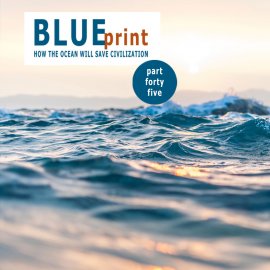21st Century Alchemy: Capturing Carbon from the Ocean
-
English
-
ListenPause
[intro music] Welcome to World Ocean Radio… I’m Peter Neill, Director of the World Ocean Observatory In the Middle Ages, philosophers, the scientists of the era, explored the planetary elements and conducted experiments that proposed to transform dross into gold. It makes for fascinating reading, particularly the similarities of systems and methods of observation, speculation, theory, experiment, and discovery, the scientific process as it is known today. As we pursue 21st century solutions to contemporary problems, we are conducting such experiments, proposing ideas, and speculating how we can use our knowledge and transform negatives into positives, without further exacerbating or extending our past mistakes into the future. One such challenge is the matter of excess carbon dioxide in the air, the carbon emissions caused by fossil fuel reliance, that is a major contributor to climate change. How do we capture that carbon, address ocean acidification and other associated impacts, without making the situation worse or creating new issues in a perpetuating cycle of negative solution? Some engineers have proposed direct air capture, pulling the carbon out of the air, using massive, expensive, and ultimately inefficient fans, and sequestering it in some kind of form and place for storage. A recent article in Hakai Magazine by Aly Hirschag https://www.hakaimagazine.com/news/petrifying-climate-change/ describes a perhaps more viable variant of this approach, capturing carbon from the ocean, a proposal suggested by Professor Gauav Sant, from the Institute for Carbon Management at the University of California, Los Angeles, https://newsroom.ucla.edu/releases/using-seawater-to-reduce-co2-in-atmos... that by filtering sea water through an electrified filter combining CO2 with contained calcium and magnesium to create a reaction to withdraw and transform suspended ions into solid forms, calcite and magnesite, in effect turning water into stone. Sant describes this alchemy as follows: “The process is a bit like a water treatment plant, but instead of taking in water and sifting out the impurities, the proposed plant would use electricity to force carbon, calcium, and magnesium to react and become solids. The ‘purified water’ would then be returned to the ocean.” Intriguingly, a byproduct of the process is hydrogen gas, which could be burned to create the required electricity and/or sold as a contribution to the operating cost. Further, the extracted carbonates, if deposited as waste locally could have negative ecosystem/habitat effect, a problem mitigated by its additional use to make concrete, in effect, a carbon neutral production of limestone for a global product that will be evermore necessary for construction of coastal defense against sea level rise and extreme ocean weather. This approach is being modeled in a UCLA laboratory, but also as start-up technology demonstration by a company called Planetary Hydrogen, based in Halifax, Nova Scotia, Canada. I am so grateful to these innovators, and also to the writers and editors of Hakai Magazine, a publication about science and society in coastal ecosystems, that I enthusiastically recommend, online at hakaimagazine.com. This is modern alchemy. What fascinates and excites me about this process is its integration with positive, amplifying outcome at each stage along the way: carbon capture from the ocean at scale; self-sustaining generation of operating energy; limited waste; minimal required real estate; and positive transformation of potential harmful by product into useful, carbon neutral construction material for local or regional use. It is elegant, efficient, touched with mystery, and captivating as a powerful utility by which to confront an urgent environmental and social problem. All you need to do is add an integrated desalination plant for freshwater production with comparable value and scale to have an astonishing new technological response to most of the world’s most pressing needs produced through positive, sustained use of the ocean. Bless the dreamers, the mad scientists and crazy engineers, whose imagination, knowledge, and calculation turn into real solutions, not nightmares, the inventors who are the true “evolutionaries” of today, the agents of radical change turning 21st century dross into gold. We will discuss these issues, and more, in future editions of World Ocean Radio. [outro music]
This week on World Ocean Radio we are discussing the challenges of excess carbon dioxide in the air and some of the engineered solutions now being employed to sequester carbon from the ocean and transform it into a solid.

The "BLUEprint Series: How the Ocean Will Save Civilization" outlines a new and sustainable path forward, with the ocean leading the way.
About World Ocean Radio
Since 2009, a weekly 5-minute podcast covering a broad spectrum of ocean issues from science and education to advocacy and exemplary projects. World Ocean Radio, a project of the World Ocean Observatory, is available for syndicated use at no cost by college and community radio stations worldwide. Contact director@thew2o.net if you are interested in becoming an affiliate or know of a radio station that should be broadcasting these episodes each week.
Image
Photo by Anastasia Taioglou on Unsplash @thenata
Resource from this episode
- DROSS
\ ˈdräs , ˈdrȯs \
1. metallurgy : the scum or unwanted material that forms on the surface of molten metal
2. waste or foreign matter
3. something that is base
- UCLA Newsroom: Could the Ocean hold the key to reducing carbon dioxide in the
atmosphere, January 12, 2021
newsroom.ucla.edu/releases/using-seawater-to-reduce-co2-in-atmosphere
- Aly Hirschag, Hakai Magazine, "Petrifying Climate Change", June 3, 2021,
hakaimagazine.com/news/petrifying-climate-change
- Planetary Hydrogen Halifax N.S. CANADA
planetaryhydrogen.com
- Login to post comments



